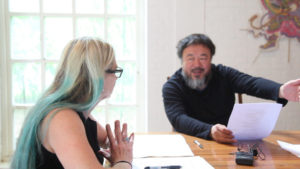
There’s years worth of story in the new documentary Ai Weiwei: Yours Truly. The documentary goes far into the Chinese artist’s life. It recounts the wrath he faced from the Chinese government. His big crime was publishing the names of the more than 5000 children who died in a Sichuanese earthquake.
It also turns out that he’s a second generation political prisoner. Ai Weiwei: Yours Truly talks to his family, recounting the oppression that their late father, poet and counter-revolutionary Ai Qing. Ai’s brothers discussed their former lack understanding as to why the government publicly shamed their father.
But the documentary’s main focus is on capturing the Chinese artist after that imprisonment. In 2013, he unfolded several installations in the most famous prison in the world, Alcatraz. Helping him is one of the co-directors, Cheryl Haines. She has to figure out the installation’s logistics since Ai’s government won’t let him leave China.
That means that Ai won’t get to see the fruits of his labor in person. However, both he and Haines comment on that disconnect through visual means. Planning and opening takes too quickly here. But the final product has the visitors effectively seeing the installations through Alcatraz’s oppressive infrastructure.
One of the main installations there are Lego portraits of political prisoners worldwide. Visitors can then write them postcards. Haines, through one of these visitors, explains, although slightly didactically, the stories behind the portraits.
But these postcards are getting through, that the prisoners are letting their inmates see that they’re not alone. One of those prisoners were lucky enough to have their relatives visit the site.
The postcards have images of the countries’ national birds or flowers, symbolizing the freedom that these political activists deserve. The movie also shows the messages that people write on those cards, indicating political intersections.
Some prisons, like the ones in Egypt, don’t allow the postcards to go through. Ai and Haines have another idea – to send voice messages to one of the inmates there, Ahmed Maher. There’s an effectiveness in hearing these messages as the camera looks out towards the Bay.
The movie eventually moves out of the Bay to the places. Worldwide, political prisoners try to make progress after their release. Haines’ camera plays around with the relative peace of those countries and what that peace is trying to hide.
The film focuses less on the prisoners who didn’t survive. This is a decision I’m OK with, as it chooses to unite the survivors. Haines sees Maher, and Ai sees Chelsea Manning. And it was nice to hear Manning talk about how much the postcards meant to activists like her.
- Release Date: 8/7/2020

